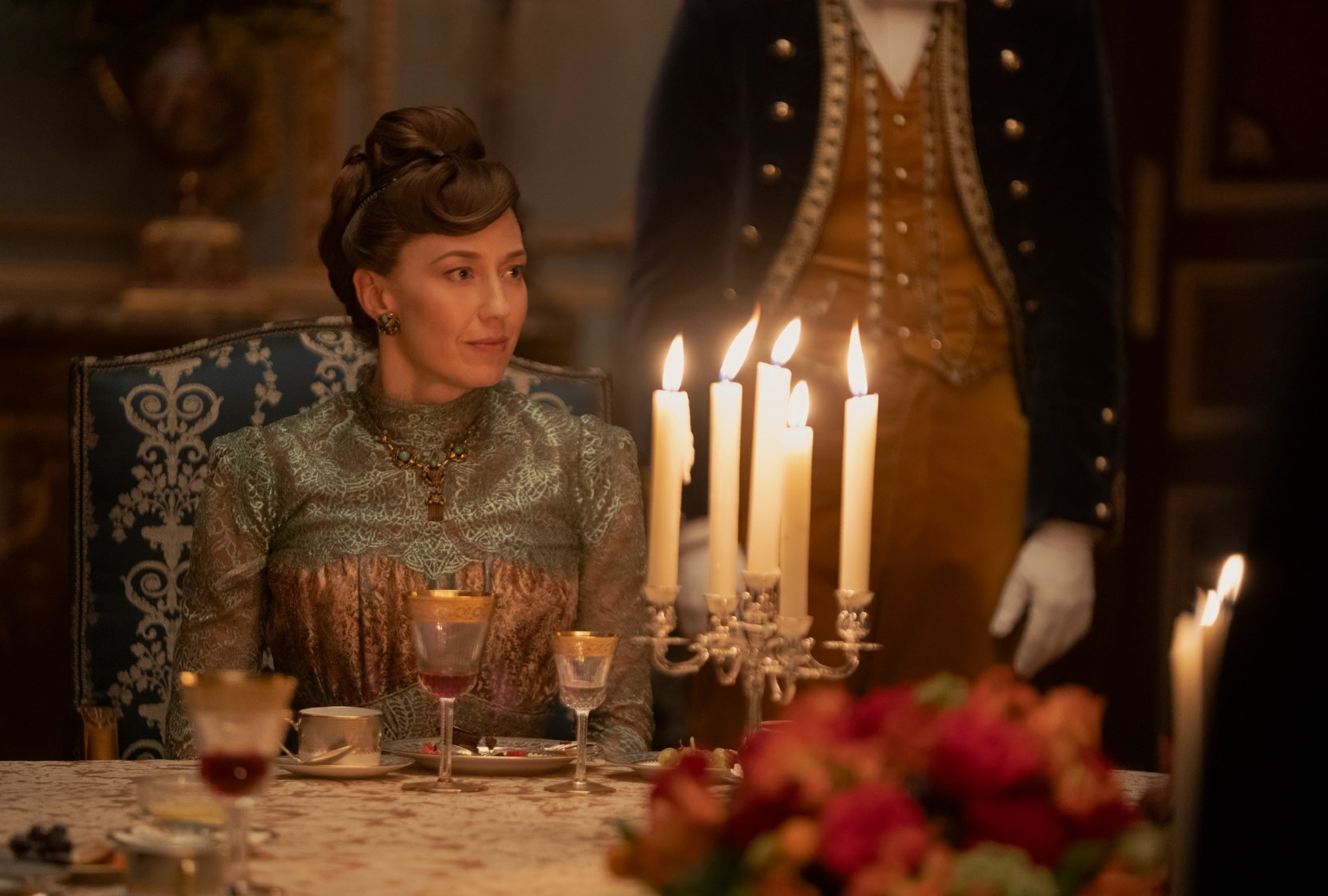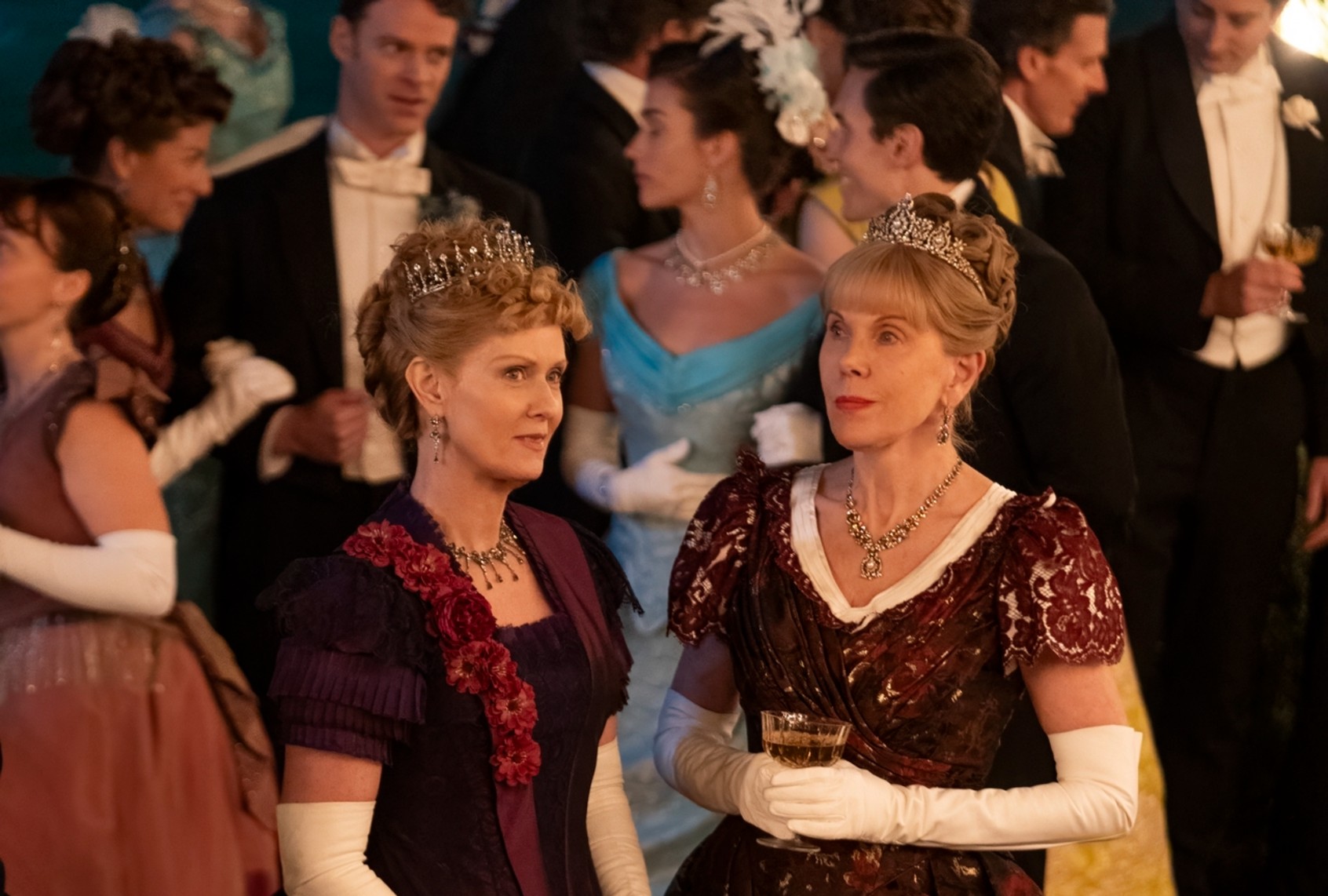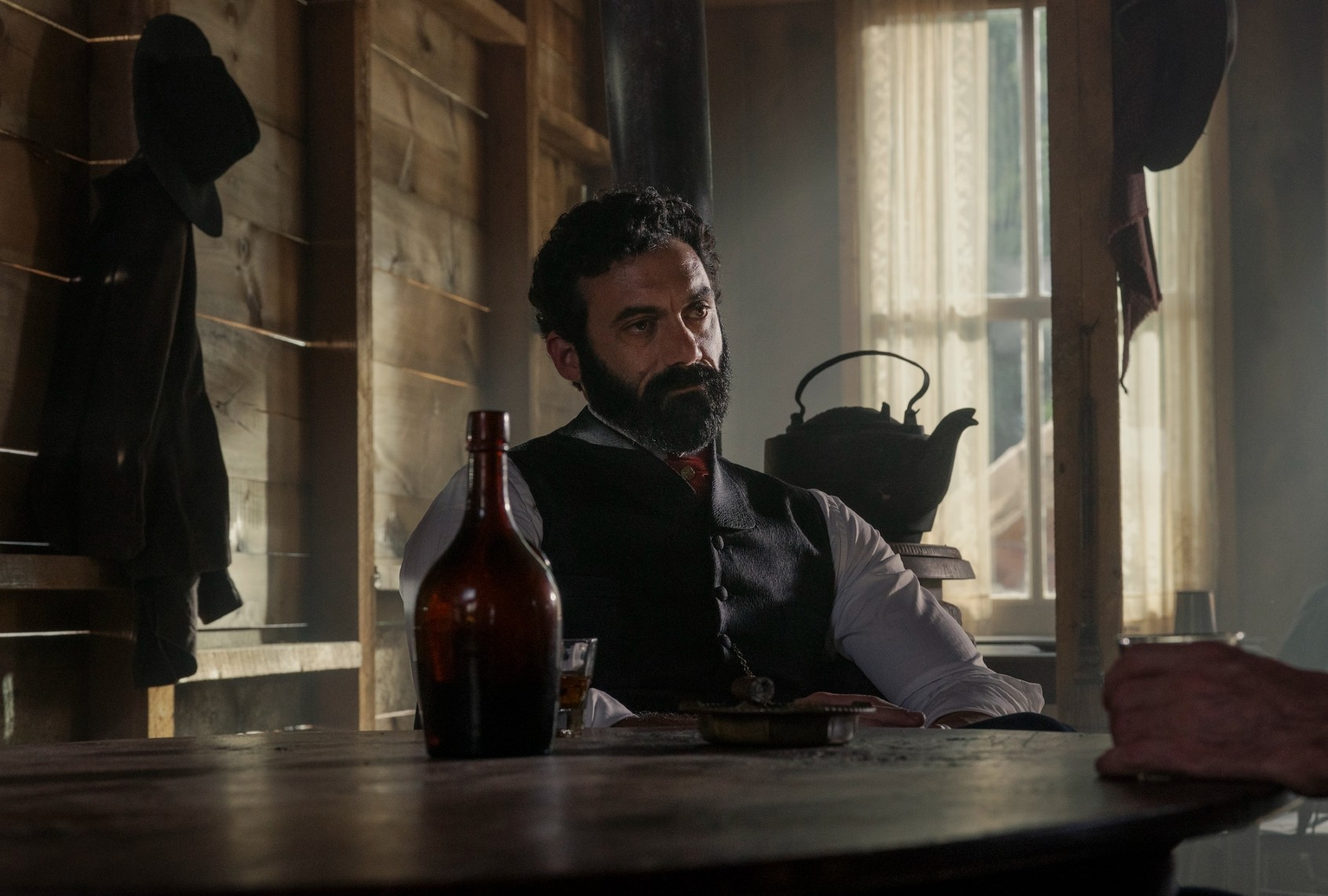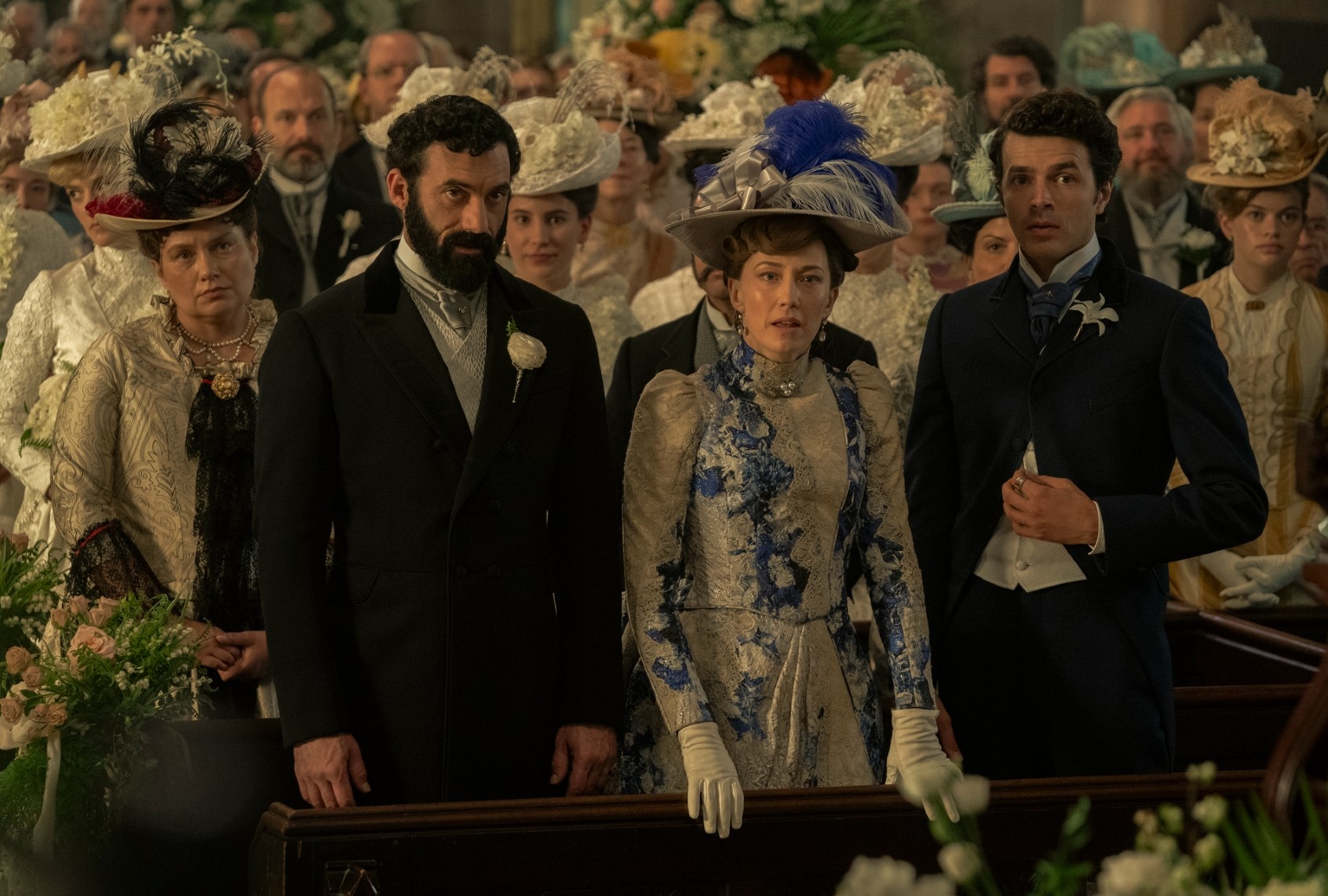Titans of industry use the bones of giants who came before to build their empires. “The Gilded Age” blares that message from its very first episode with the furnishings being hauled into the new home of George Russell (Morgan Spector) and his wife Bertha (Carrie Coon) on Manhattan’s 61st Street.
Their old-money neighbors find the enormous, gleaming structure to be garish. But series creator Julian Fellowes uses Bertha’s specific sweep of its household details to tell us more about the Russells than any exterior architectural expression could reveal. As she buzzes through their home, Bertha and her decorator blithely name-drop the provenance of chandeliers, rugs and paintings.
She enters George’s study for an affectionate fly-by, where George does something that, watching it now, translates as a defining gesture. He crosses one flamboyantly shod foot over another on his desk with churlish satisfaction and takes a deep draw on his cigar.
“Careful,” says Bertha. “That table belonged to King Ludwig of Bavaria.”
George grins. “He had it once, I’ve got it now.”
Props to the robber barons of yesteryear — at least they had style. Contrast this with “MAGA Mark,” as Meta founder Mark Zuckerberg is called in a new Financial Times profile by Hannah Murphy. “Hoodies have been swapped for shearling coats, gold chains and a $900,000 Greubel Forsey watch,” writes Murphy. “The military-grade haircut is gone, in favour of a luxuriant ginger mullet.” The sartorial messaging is that elegance is a sucker’s game. Real money announces itself by being the gaudiest in any room.
Elegance is a sucker’s game. Real money announces itself by being the gaudiest in any room.
Fellowes, who created “Downton Abbey,” knows his nobles. This makes me suspect that he didn’t choose the desk’s previous owner at random. Ludwig II of Bavaria was a zealous aesthete with enough personal wealth to treat part of what is now Germany as an architectural canvas. Expansive visions of lasting magnitude spur George, too, but the endgame is dominating all he surveys.
Even so, George is charming. Based on what little we know about how George obtained his wealth, he is one of those mythical “self-made” millionaires who keep most Americans hooked to the capitalist slot machine. Some may see him as the Donald Trump of his time, except George’s businesses are profitable, and his risks tend to pay off.
Bertha came from nothing in a very real way — she’s the daughter of potato farmers. Supposedly, the Russells are like us, making them the home team. Unlike “old money” aristocracy, they have an inkling of what it’s like to struggle. That doesn’t make either George or Bertha acutely sympathetic to the workers they ignore or exploit.
“The Gilded Age” embarks on its third season as America writhes in what many believe to be its death throes. While that’s yet to be definitively proven, we’re certainly at the end of a previous epoch in which upward mobility felt more achievable. What’s taking shape looks a lot like the places to which we’ve already been.
“The Gilded Age” embarks on its third season as America writhes in what many believe to be its death throes. While that’s yet to be definitively proven, we’re certainly at the end of a previous epoch in which upward mobility felt more achievable.
In 2025, the total net worth of all U.S. households is close to $160 trillion, according to Federal Reserve data analyzed by Visual Capitalist. The richest 50% of Americans own about 98% of that wealth, amounting to around $156 trillion. Of that number, the 1.3 million families that comprise the top 1% possess about $49 trillion — just shy of a third of our nation’s total.
Around 1882, when this series begins, around 4,000 families, or less than 1% of the population, held as much wealth as the other 11.6 million families combined. That statistic comes from the PBS documentary that shares its name with this show.
What that “Gilded Age” does that Fellowes’ drama shies from is look beyond the chandelier crystals and luxurious gowns to amply consider the desperate conditions lived by those propping up this conspicuous glamour.
 Carrie Coon in “The Gilded Age” (Karolina Wojtasik/HBO)
Carrie Coon in “The Gilded Age” (Karolina Wojtasik/HBO)
The counterpoint is that the good life is prettier. Nobody wants to be reminded of that detail or the frightening reality that many of us are a lot closer to being the people who work for the Russells than becoming George Russell. Would that be so bad? His servants’ uniforms are fancier than those of his neighbors.
Three seasons after George and Bertha carted their majestic plunder from Old Europe into their showy manse, they’ve laid claim to New York society. Bertha has her sights set on the English aristocracy next, with plans to marry her daughter Gladys (Taissa Farmiga) to a duke.
George, now firmly established himself as one of New York’s premier financial potentates, turns his gaze in the direction of the setting sun, aiming to cut a swath of influence to the other coast. In the 1880s, nothing west of New York belonged to any single person or corporation. Yet.
In the late 19th century, it was railroad men who laid claim to America’s future and its treasure. Today, Silicon Valley billionaires bleed us dry by siphoning wealth from the middle and working class through tax cuts. Both persuaded themselves and a sizable portion of their admirers that their greed was the rightful spoils of their genius.
If others deserved what they had, or have, they’d also have their fill instead of complaining about empty bellies.
We need your help to stay independent
History’s refrain echoes around us, whether we choose to heed or ignore the vibes. More of us are waking up to the present alarm, even if few are moved to consult a selection of books spelling out the similarities shared by modern technocrats and 19th-century robber barons. Of course, you could just start watching this show.
“The Gilded Age” has always plied high-toned melodrama as its chief asset, but Season 3 ripens the starched formality of previous episodes into succulence. Intertwining plots are rife with reversals of fortune, starting with the Russells’ neighbors across the street.
Season 2 closed with Agnes van Rhijn (Christine Baranski) losing her vast fortune in a scam due to her son, Oscar (Blake Ritson), falling prey to a scam. Fortunately, Agnes’ mousy sister Ada (Cynthia Nixon) married a secretly rich pastor who generously kicked the bucket, leaving her his fortune. That means she pays the bills these days.
 Cynthia Nixon and Christine Baranski in “The Gilded Age” (Karolina Wojtasik/HBO)
Cynthia Nixon and Christine Baranski in “The Gilded Age” (Karolina Wojtasik/HBO)
Other aspects of the Van Rhijn household might be changing, too. Their household’s footman, Jack (Ben Ahlers), has invented a new type of clock that he and the Russells’ son, Larry (Harry Richardson), are on the verge of bringing to the market. And in a fledgling courtship that would unite one of New York’s old money families with the new money clan at the top of the social pyramid, Larry has eyes for Agnes and Ada’s niece, Marian (Louisa Jacobson).
Fellowes and his fellow showrunner Sonja Warfield also broaden their view of social stratification with a look at Black society as Peggy Scott (Denée Benton) expands her sphere of influence as a writer.
As is the case in “Downton,” the rich protagonists and their servants in “The Gilded Age” are portrayed as one grand family, and people like Agnes and Ada as racially enlightened.
Peggy’s journalistic success is encouraged by her parents, Dorothy (Audra McDonald) and Arthur (John Douglas Thompson), members of New York’s Black elite. They are, nevertheless, looked down on by the likes of Mrs. Elizabeth Kirkland (Phylicia Rashad), who proudly reminds anyone within earshot that she comes from freemen.
It doesn’t take much (if any) searching to find the nobility in these figures, since they’re written with a natural sensitivity and, in the main, empathy for their neighbors and the people who work for them. This is in keeping with Fellowes’ penchant for purveying a fantasy of class relationships foregrounded by unforced comity and respect. As is the case in “Downton,” the rich protagonists and their servants in “The Gilded Age” are portrayed as one grand family, and people like Agnes and Ada as racially enlightened.
Using the same paint to render George and Bertha, however, yields a devious kind of portrait. In a season where a major subplot revolves around what women lose in high society divorces, George and Bertha look like romantic figures — affectionate with each other, and concerned about their children’s happiness. (This becomes a flashpoint later in the season.)
We’re constantly reminded that George’s heart is in the right place when it comes to family matters. Beyond his front door, however, he can be ruthless. To a point.
A subplot in Season 2 sees one of George’s steel mills grind to a halt when its workers go on strike, demanding eight-hour workdays and better living conditions. At first, George is ready to do anything to put down the labor stoppage, including gunning down his laborers. But seconds before the hired goons fire their rifles, George calls off his murderous threat. “These men have families!” he declares. What a great guy, right?
Soon after, we see him shrewdly float terms tainted with a racist poison pill designed to split his employees’ unity and weaken future negotiations.
Season 3 sees George set in motion designs to build a railroad line connecting the East and West coasts. Given recent events, we’d be right to view him as something other than a hero.
Start your day with essential news from Salon. Sign up for our free morning newsletter, Crash Course.
In the short term, George’s proposed cross-continental railway would decimate land and livelihoods, exploit the working class and crush any bodies standing in his way. Before he sits down to negotiate with the men who own the land he needs to purchase in Morenci, Arizona, George dismisses them as “stupid clodhoppers” and coolly declares he’ll pick them off one by one.
But in the long term, that railway line will bring a version of prosperity to people and places that couldn’t have dreamed of it otherwise. That’s George’s sales pitch, anyway. The obvious bonus of all this for him and his fellow investors is that success will make the Russells astronomically wealthier than they already are. Failure could ruin them.
 Morgan Spector in “The Gilded Age” (Jon Pack/HBO)
Morgan Spector in “The Gilded Age” (Jon Pack/HBO)
By now, though, “The Gilded Age” audience has been conditioned to want George to succeed. Returning to our old friend Ludwig for a moment, note that he was known as “Mad King Ludwig” to the people who wanted to depose him, starting with his courtiers.
But his subjects apparently adored the guy, which is part of the reason Ludwig was also known as “the Swan King” or “the Fairy-Tale King.” Both sobriquets stem from Ludwig’s penchant for building gargantuan displays of excess at a clip that placed him in massive debt. Ludwig’s signifiers were castles; George’s are factories, railways and a wife dedicated to ensuring his power is acknowledged throughout the city and across the Atlantic.
One day, a new class of men will eclipse the example set by industrialists like George Russell. They will build rockets and satellites from which they can gaze down on all the people who have less than they do. They will run roughshod over the taxpayer-funded safety net designed to help our most vulnerable and sneeringly refer to Americans who use federal benefits as members of the parasite class.
Maybe that’s why “The Gilded Age” still manages to make George and Bertha seem admirable. Disrespecting a king’s old desk doesn’t compare to stepping on an entire country. But every society’s rise and fall kicks off somehow.
Season 3 of “The Gilded Age” premieres at 9 p.m. Sunday, June 22 on HBO and streams on Max.
Read more
about “The Gilded Age”


